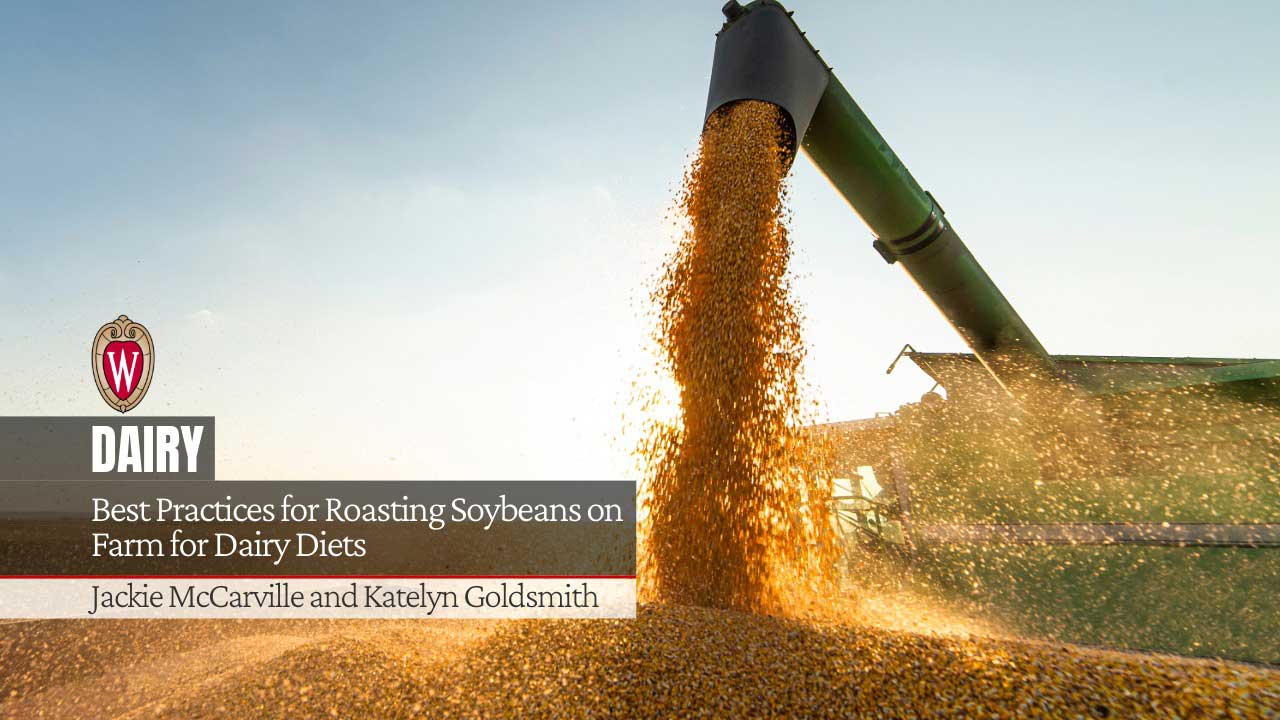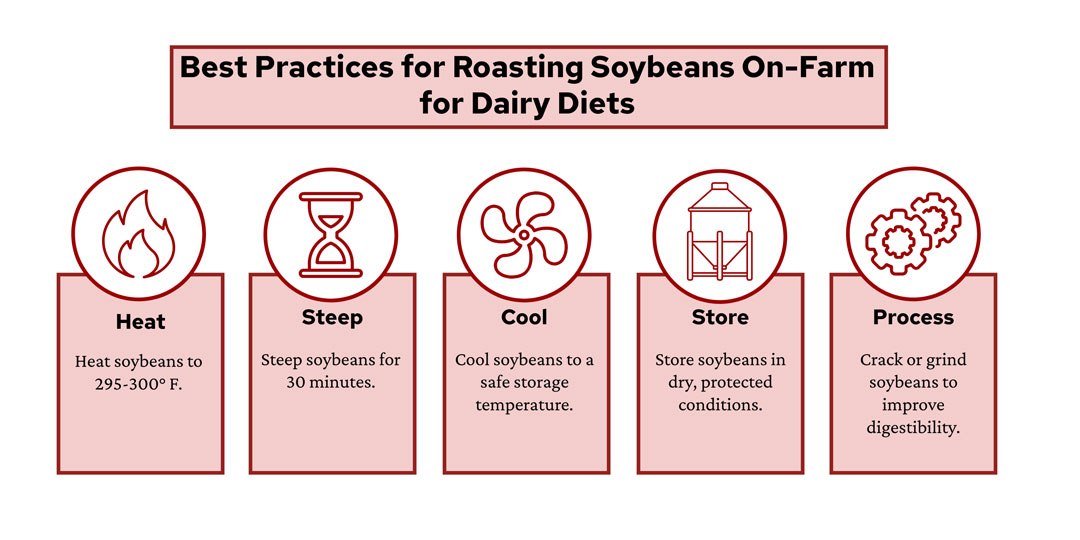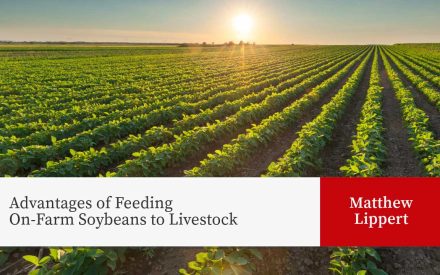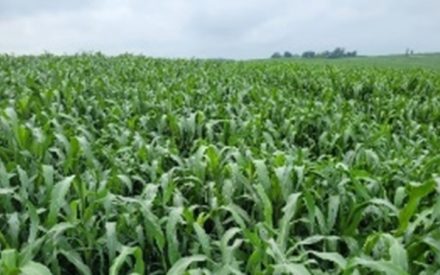
Introduction
Soybeans are a great source of protein and fat for dairy rations, and the recent introduction of high-oleic soybeans has renewed the interest in feeding roasted soybeans. Roasted soybeans have increased protein digestibility, higher rumen undegradable protein (RUP) content, and reduced presence of anti-nutrients like trypsin- inhibitors . Roasting denatures protein, increasing the RUP content from around 25% to between 40 to 60%. This results in more protein bypassing the rumen for intestinal absorption. Roasting also improves the accessibility of fats in soybeans, boosting their energy contribution.
Roasting Options
The two main types of roasters used are drum roasters and high-temperature air dryers. With a drum roaster, soybeans drop into a rotating drum where air temperatures range from 400-600° F. They will remain in this environment for approximately one minute before exiting. If soybeans remain in that hot environment for much longer, they will become scorched with damage to the soybean. With high-temperature air dryers, the soybeans are conveyed over a perforated floor where hot air is blown. This route is more expensive as the equipment needed has higher costs, but scorching is less common and it may be more energy efficient. On the other hand, smaller farms looking to roast their own beans might use an electric grain roaster. This is an automated machine that uses electricity to heat an enclosed chamber.
Best Practices for Roasting Soybeans for Dairy Cattle
When feeding soybeans as a source of RUP for dairy cattle, following proper roasting procedures is essential. Improper roasting can compromise digestibility, negatively impact milk production and component yield, and ultimately limit return on investment. To ensure optimal results, soybeans must be correctly heated, steeped, cooled, stored, and processed.

(Goldsmith, 2025).
Heating
Soybeans should be heated to 295-300° F and maintain this temperature as they exit the roaster. This range has been shown to optimize RUP content and digestibility (1, 2).
Heating soybeans serves two primary purposes for dairy cattle diets:
- Increases the concentration of RUP and post-ruminally available lysine (1)
- Deactivates undesirable enzymes (3)
If beans are underheated, RUP levels will be lower, and more protein will be degraded in the rumen. Additionally, urease activity may persist, which can cause complications in diets containing urea (4).
On the other hand, overheating soybeans can damage amino acids, especially lysine, making them less digestible (1). Overheated beans can also become brittle, increasing ruminal digestibility and reducing the amount of protein available for post-ruminal digestion (5).
Steeping
After roasting, soybeans should be steeped (held without cooling) for 30 minutes in an enclosed unit. Steeping is the process of keeping the soybeans at a consistent temperature, allowing heat to uniformly penetrate the beans, enhancing the effectiveness of the heat treatment (6).
Beans may experience an initial drop in temperature due to moisture evaporation, but their temperature should quickly stabilize (1). To ensure consistent heat retention, beans should be steeped in enclosed units such as bins, covered gravity wagons, or industrial totes. Avoid steeping beans in open areas like concrete pads. This can cause uneven cooling and result in inconsistent nutrient profiles throughout the batch.
Cooling
Following steeping, beans must be cooled to a safe handling and storage temperature. This can be achieved using aeration fans or spreading the beans on a clean, open surface. Proper cooling helps prevent spoilage and preserve bean quality.
Guidelines for storage temperature are (7,9):
- Maintain soybean temperatures below 60° F from March to October.
- Keep soybeans below 45° F from November to February
Storage
Cooled soybeans should be stored in dry, debris free conditions such as in bins or covered flat storage. Storage bins must be maintained to minimize moisture and air infiltration. Follow best practices for bin storage, including the following (8):
- Regular inspections of bins and aeration systems.
- Proper ventilation and aeration of stored grain.
- Monitor bean condition regularly. Check for spoilage weekly in warm weather and biweekly in cold weather (9).
High oleic soybeans should be stored separately from conventional beans. This both simplifies management but also preserves the marketability of the soybeans, which is significantly reduced if beans are comingled.
Storage duration depends on moisture and temperature. See Table 1 for estimated allowable storage times of soybeans. The suggested storage times in Table 1 are based on whole, unroasted beans. Roasting and/or grinding beans will likely affect allowable storage times.
| Moisture Content |
30° F | 40° F | 50° F | 60° F | 70° F | 80° F |
|---|---|---|---|---|---|---|
| 11% | * | * | * | * | 200 days | 140 days |
| 12% | * | * | * | 240 days | 125 days | 70 days |
| 13% | * | * | 230 days | 120 days | 70 days | 40 days |
| 14% | * | 280 days | 130 days | 75 days | 45 days | 20 days |
| 15% | * | 200 days | 90 days | 50 days | 30 days | 15 days |
| 16% | * | 140 days | 70 days | 35 days | 20 days | 10 days |
Table adapted from North Dakota State University (10).
*Allowable storage time exceeds 300 days.
Allowable storage time is the storage period before quality loss is expected to affect grain quality.
Allowable storage time is cumulative. If 16% moisture soybeans were stored for 35 days at 50° F, one-half of the storage life has been used. If the soybeans are then cooled to 40° F, the allowable storage time at 40° F is only 70 days.
This table is for whole, unroasted soybeans. Roasting and/or grinding of soybeans can impact allowable storage times.
Processing
Roasted soybeans should be processed to maximize digestibility in dairy diets. Cracking beans into quarters or eighths is effective (11, 12, 13). Grinding to a particle size around 700-800 microns can further improve digestibility (14, 15). Grinding finer than 700 microns remains an area for future research as it may increase ruminal protein digestion but therefore decrease the protein available for post-ruminal digestion. Additionally, finely ground soybeans can cause flow issues in bins and augers.
Processed soybeans should be stored in clean, dry areas. Formal research has not established recommended storage lengths for processed high-oleic soybeans but a safe rule of thumb is to process and store only a one- to two-month supply at a time.
Testing
Sampling and testing are an important quality control step when roasting soybeans on-farm. Listed below are potential laboratory tests that can help identify when roasting has been done properly. Although some tests are more reliable than others, all options can help identify the extremes of over- or under-roasting. Due to potential variation between labs, it is best to send samples to the same lab each time.
- Protein Dispersibility Index (PDI) lets you know when you have roasted adequately and is helpful with identifying when soybeans have been underheated. Recommended values are 9-12, above 14 is considered underheated (16).
- A urease activity test can also determine if heat treatments have been added to lower the anti-nutritional effect of urease. The results are expressed as an increased unit of pH. A range of .05-.10 suggests beans have been properly heated (16).
- In Situ RUP 16h can be used to determine if roasting was adequate to achieve a substantial change in RUP (17). It can estimate the percentage of RUP and protein digestibility. You can consider using this if you are concerned that procedures like steeping are not being done well enough which would result in lower RUP digestibility than if properly roasted.
- In vitro RUP (Ross RUP analysis) is more sensitive than In Situ RUP, but not perfect. Similar to the in situ test, the Ross analysis works well for identifying if beans have been poorly or adequately roasted.
- Potassium hydroxide solubility (KOH) testing methods were developed for defatted soybean meal and researchers are not confident that the results are reliable for full-fat soybeans.
Summary
Roasted soybeans are a valuable source of protein and RUP for dairy cattle. Following best practices for on farm roasting including heating, steeping, cooling, storing, and processing, is essential for optimal results. Additionally, testing serves as an important quality control step for this process. Implementing these practices can help you successfully roast soybeans on your farm.
Author

Jackie McCarville
Regional Dairy Educator – Jackie’s primary focus is dairy operations. She has experience in the private sector in animal nutrition and on dairy farms.

Katelyn Goldsmith
Dairy Outreach Specialist– In her role as a statewide Dairy Outreach Specialist, Katelyn connects research with practical farm management practices to create educational programming addressing the needs of Wisconsin dairy producers.
Reviewers
Shawn Conley
Professor, State Soybean and Small Grain Specialist
University of Wisconsin-Madison
References
- Hsu, J.T., & Satter, L.D. (1995). Procedures for measuring the quality of heat-treated soybeans. Journal of Dairy Science, 78:1353-1361. https://doi.org/10.3168/jds.S0022-0302(95)76757-1
- Faldet, M.A., Son, Y.S., & Satter, L.D. (1991). Chemical, in vitro, and in vivo evaluation of soybeans heat-treated by various processing methods. Journal of Dairy Science, 75:789-795. https://doi.org/10.3168/jds.S0022-0302(92)77817-5
- Eastridge, M. (2024). Feeding roasted soybeans to dairy cattle. Buckeye Dairy News, 26(3). Access online at https://dairy.osu.edu/newsletter/buckeye-dairy-news/volume-26-issue-3/feeding-roasted-soybeans-dairy-cattle
- Lehmkuhler, J., & VanValin, K. (2021). Feeding soybeans to beef cattle. University of Kentucky Cooperative Extension Service. Access online at https://publications.ca.uky.edu/sites/publications.ca.uky.edu/files/ASC245.pdf
- Aldrich, C.G., Merchen, N.R., Nelson, D.R., & Barmore, J.A. (1995). The effects of roasting temperature applied to whole soybeans on site of digestions by steers: II. Protein and amino acid digestion. Journal of Animal Science, 73:2131-2140. https://doi.org/10.2527/1995.7372131x
- Faldet, M.A., Voss, V.L., Broderick, G.A., & Satter, L.D. (1991). Chemical, in vitro, and in situ evaluation of heat-treated soybean proteins. Journal of Dairy Science, 74:2548-2554. https://doi.org/10.3168/jds.S0022-0302(91)78432-4
- Buschermohle, M.J., Pordesimo, L.O., & Wilhelm, L.R. (n.d.) Maintaining quality in on-farm stored grain. University of Tennessee Extension. Access online at https://utia.tennessee.edu/publications/wp-content/uploads/sites/269/2023/10/PB1724.pdf
- Nelson, K. (2024) Grain management 101. Iowa Soybean Association. Access online at https://www.iasoybeans.com/newsroom/article/isr-september-2024-grain-management-101
- Hurburgh, C.R. (2008). Soybean drying and storage. Iowa State University Extension and Outreach. Access online at https://isuaamncus122stg.blob.core.windows.net/shop/PM1636.pdf
- North Dakota State University. (n.d.). Allowable storage time for cereal grains, malting barley, and soybeans. Access online at https://www.ndsu.edu/agriculture/ag-hub/ag-topics/crop-production/drying-storage/allowable-storage-time-cereal-grains-malting-barley
- Dhiman, T.R., Korevaar, A.C., & Satter, L.D. (1996). Particle size of roasted soybeans and the effect on milk production of dairy cows. Journal of Dairy Science, 80:1722-1727. https://doi.org/10.3168/jds.S0022-0302(97)76104-6
- Tice, E.M., Eastridge, M.L., & Firkins, J.L. (1992). Raw soybeans and roasted soybeans of different particle sizes. 1. Digestibility and utilization by lactating cows. Journal of Dairy Science, 76:224-235. https://doi.org/10.3168/jds.S0022-0302(93)77341-5
- Holtz, C., Davis, L., Barmore, J., Nichols, S., Nicholson, C., Lock, A., & Harvatine, K. (2025). High oleic soy in dairy rations, frequently asked questions. US Soy. Access online at https://can.ussoy.org/wp-content/uploads/2025/07/High-Oleic-Soy-in-Dairy-Rations-FAQ.pdf
- Bales, A.M., & Lock, A.L. (2024). Effects of raw and roasted high oleic soybeans on milk production of high producing dairy cows. Journal of Dairy Science, 107:10869-10881. https://doi.org/10.3168/jds.2024-25092
- Weld, K.A., & Armentano, L.E. (2018). Feeding high oleic acid soybeans in place of conventional soybeans increases milk fat concentration. Journal of Dairy Science, 101:9768-9776. https://doi.org/10.3168/jds.2018-14498
- Lippert, M. (n.d.) Advantages of feeding on-farm soybeans to livestock. Access online at https://dairy.extension.wisc.edu/articles/advantages-of-feeding-on-farm-soybeans-to-livestock/
- Raver, K and Goeser, J. (2025) Evaluating Soybean Roasting Efficacy. Access online at https://rockriverlab.com/file_open.php?id=557


 ▶️ Watch: Cows need fiber too! Storage and feeding tips to minimize nutrient losses
▶️ Watch: Cows need fiber too! Storage and feeding tips to minimize nutrient losses Advantages of Feeding On-Farm Soybeans to Livestock
Advantages of Feeding On-Farm Soybeans to Livestock ▶️ Watch: How Can Nutrition Help Us in Taming Inflammation and Improving Cow Health
▶️ Watch: How Can Nutrition Help Us in Taming Inflammation and Improving Cow Health Cocktail Forage Mix Yield, Quality, and Use in Lactating Cow Diets
Cocktail Forage Mix Yield, Quality, and Use in Lactating Cow Diets


